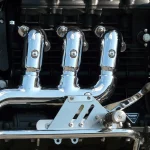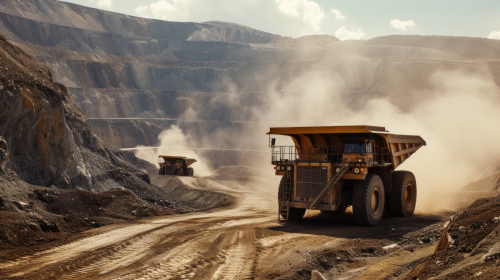
Automotive Sensors Design
January 2, 2025
Exhaust Muffler Training
October 20, 2025
Automotive Sensors Design
January 2, 2025
Exhaust Muffler Training
October 20, 2025Mining operations are essential for extracting valuable resources, but they come with their own set of challenges. One significant issue is the noise generated by mining trucks. This blog post explores the challenges of mining truck noise, its effects on operators and neighbors, the associated costs, and the critical role of mufflers in reducing this noise on mining sites.
Mining trucks are inherently noisy due to their powerful engines and hydraulic components. The noise levels can reach up to 100 dB, which is well above the safe threshold of 85 dB for operator safety. Prolonged exposure to such high noise levels can lead to Noise-Induced Hearing Loss (NIHL) among operators. Additionally, the low-frequency noise generated by these trucks can travel long distances, affecting nearby communities.

Downtime Caused by Noise
Excessive noise can lead to significant downtime in mining operations. For instance, if noise levels exceed regulatory limits, operations may need to be halted to implement noise control measures or even stop the mining operations. This downtime can be costly, with estimates suggesting that downtime for haul trucks can cost around $5,000 per hour. Over a year, this can add up to millions of dollars in lost revenue.
The financial implications of mining truck noise are substantial. Apart from the direct costs associated with downtime, there are also costs related to health care for affected workers and potential fines for non-compliance with noise regulations. Additionally, the negative impact on community relations can lead to further financial and reputational damage for mining companies.
Mining Labor Noise Safety According to ANSI/SAE J1166 MAY90
The ANSI/SAE J1166 MAY90 standard provides guidelines for measuring and controlling noise levels in mining environments to protect workers' hearing. According to this standard, the permissible exposure limit (PEL) for noise is an 8-hour time-weighted average (TWA) of 90 dB(A). Higher noise exposures are permitted for shorter periods, but prolonged exposure to levels above this threshold can lead to Noise-Induced Hearing Loss (NIHL). The standard emphasizes the importance of engineering controls, such as mufflers, to reduce noise at the source. Additionally, it recommends regular noise monitoring and the use of personal protective equipment (PPE) to safeguard workers' hearing.
By adhering to these guidelines, mining companies can ensure a safer working environment and comply with regulatory requirements, ultimately protecting their workforce from the harmful effects of excessive noise.
The Importance of Mufflers in Reducing Noise
Mufflers play a pivotal role in reducing the noise generated by mining trucks. Here are some key reasons why mufflers are essential:
- Noise Reduction: Mufflers are designed to attenuate the noise produced by combustion engines. They contain tubes, baffles, and channels that direct exhaust gases in specific ways to break up or absorb sound waves and reduce the acoustic output. The muffler could be either absorptive, reactive, or combined, which helps to significantly lower noise levels.
- Environmental Impact: A quieter muffler is superior from an environmental standpoint. Uncontrolled noise pollution can adversely affect the health of mine site personnel and surrounding ecosystems. Mufflers help create a safer and more sustainable mining environment by reducing noise.
- Exhaust System Optimization: Mufflers are an integral part of the exhaust system, which also helps in filtering emissions and improving overall engine performance. A well-designed muffler can enhance the efficiency of the exhaust system backpressure, leading to better fuel economy and reduced emissions.
- Durability and Maintenance: Modern mufflers are built to withstand the harsh conditions of mining operations. They are made from durable materials that can handle high temperatures and corrosive environments. Regular maintenance of mufflers ensures they continue to perform effectively, minimizing noise and extending the lifespan of the exhaust system.
Enostack Exhaust System Design
At Enostack, we are keen on designing mufflers for mining trucks to decrease the noise below the OEM or aftermarket mufflers to reach a target noise level on site. Or increase the exhaust system efficiency by mitigating the backpressure from the exhaust system to increase the truck's performance. Check out our Exhaust Systems Portfolio to know more about how we helped dump trucks such as CAT 795, CAT 793D, and the giant mining excavator Hitachi EX 5600-7 to lower noise emissions and reduce back pressure. Our target customers are Mining Service Companies and Mining Environmental Consultants.
Other Ways to Reduce Mining Truck Noise
Several strategies can be employed to reduce the noise generated by mining trucks, regardless of the focus on mufflers:
- Regular Maintenance: Ensuring that all exhaust system components, including mufflers, are well-maintained can prevent excessive noise caused by faulty parts.
- Acoustic Barriers: Installing barriers around the mining site can help block the propagation of noise to surrounding areas.
- Operator Training: Training operators on best practices for minimizing noise can also be effective.
- Community Engagement: Engaging with the local community to address their concerns and implementing noise monitoring systems can help maintain good relations.
By adopting these measures, mining companies can mitigate the impact of noise, ensuring a safer and more harmonious environment for both workers and neighboring communities.
Contact Us
We'd love to hear from you! Whether you have questions, need a consultation, or want to discuss a project, feel free to reach out.

